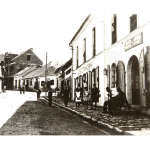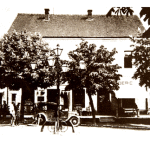The name of the Town of Prnjavor is of Greek origin and comes from the word Pronija, which in the Byzantine administrative system indicating the secular and church property. Prnjavor was probably a property of the nearby Orthodox monasteries. The fact is that in the immediate vicinity of Prnjavor there are monasteries Stuplje, Liplje, Donji Detlak, Osovica.
The area of the Municipality of Prnjavor was inhabited in prehistoric times, as evidenced by archaeological sites on several places. The most significant traces of the prehistoric civilization were found on the hill Luščić, in the vicinity of Kulaši Spa, where the remains of the settlement from the time of the Paleolithic are located, and represend one of the most important sites from the period of the earlier Stone Age in North Bosnia. In the villages Popovići and Štrpci artifacts, indicating the presence of a modern man, i.e. homo sapiens, have been found. Apart from the prehistoric period, in the Municipality of Prnjavor there are also sites that belong to the period of Roman rule, as well as the period of the Middle Ages.
It is believed that Prnjavor was created in the 16th century, although the first written trace of Prnjavor settlement dates back to the end of the 17th century, and it is found in an Austrian military report by an unknown author, from 1688 to 1699. It records that in the area between Vrbas and Ukrina there were, among other, two smaller settlements: Prnjavor (Bernjavor) and Lessnia, small marketplaces, each having abour 80 households. The name of Prnjavor is also found in a witing from 1725, and there is a more detailed description of Prnjavor in other writing, from 1780. In the XIX century, the name of Prnjavor in written sources is much more common.
In the second half of the nineteenth century, a trade and merchant families were developing, so Prnjavor was more closely connected with other areas in Bosnia and Herzegovina, and even beyond. The families of Trifkovic, Stankovic, Markovic, Jovanovic, Ostojic, Bajic and others are significant for the time. More intense economic development Prnjavor was experiencing at the end of the XIX century when, according to the policies of the ruling Austro-Hungarian Empire, a large number of members of different nations were settled in the area: Italians, Ukrainians, Czechs, Slovaks, Germans, Hungarians, Jews, Roma and other peoples. The population census conducted at the end of the 19th, and early 20th centurie, confirmed the presence of 19 different nations in the area, and from that period, the name “Little Europe” remained. From that period Prnjavor has been experiencing greater urbanization and development in architectural and constructional terms. In addition to the sacred objects of modest appearance that existed in earlier times, the significant objects were built, contributing to the physiognomy of the place. A particularly important period was from 1896 to 1904, when one new building was built in Prnjavor, serving as the headquarters of the District Heads appointed by Austro-Hungarian Empire. The hospital, the hotel “Popović”, expanded streets and sidewalks were also built at that time.
In 1842, a Serbian confessional school was opened, and from the school year 1886/87, a state, communal school started to work. After the end of the First World War, and the creation of the Kingdom of Serbs, Croats and Slovenians, only state schools worked in Prnjavor.
In the First World War, Prnjavor was liberated on November 21, in 1918, when the Serbian army, headed by Lieutenant Ratko Blagotić, entered the town. By the end of the First World War, Prnjavor district became part of the Kingdom of Serbs, Croats and Slovenes. Later on, with the new state territorial reorganization from 1929, it became part of the Vrbas Banovina and the Kingdom of Yugoslavia. This period was characterized by intensive economic and urban development, and Prnjavor, after the agrarian reform, was becoming the center of the region, as well as the administrative, cultural and educational center.
In the Second World War, Prnjavor was liberated on July 10, in 1943, by the action of the Kozara Brigade and the Prnjavor Military Detachment.
After the Second World War, more precisely in 1951, as a part of the Socialist Republic of Bosnia and Herzegovina, ie the Socialist Federal Republic of Yugoslavia, the Municipality of Prnjavor was formed, and the Town of Prnjavor gets the function of the municipal administrative center. In the past sixty years, significant economic capacities and infrastructure have being developed in the area, and the municipal center takes on the characteristics of the urban settlement.

















